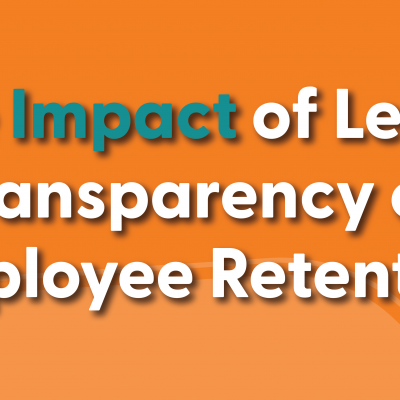The importance of employee retention as it pertains to the success and continuity of your organization is no great secret. Preserving your people for the long haul is widely considered a vital ingredient for your stability and growth recipe.
Ambiguity arises, however, when determining the most effective approach for your organization to initiate the preservation process, and how to do so when your employees are still in love with your workplace, not when they’ve got one foot out the door.
In the competitive landscape of talent acquisition, the retention of skilled and experienced employees is essential for maintaining operational efficiency, preserving institutional knowledge, and nurturing a positive workplace culture. High turnover not only results in significant costs but also disrupts team dynamics, potentially impacting overall productivity.
While mileage may vary depending on the role being filled and your hiring market, estimates for how much it can cost to replace an employee can reach up to 3x-4x of the lost employee’s salary. And while that may be a big blow to your bottom line, it again does not include the loss of said institutional knowledge or impact to your company culture.
As new trends sprout and HR and People Ops teams look to adapt, there’s an easy and effective (and oft-overlooked) differentiator you can implement in your organization to help keep employees feeling supported and your retention numbers high.
You probably guessed it based on the title of this blog, but your employee’s leave of absence experience speaks volumes about how your organization steps up when your people need it most, and the more transparent your process is from start to finish the more engaged and productive your employees will be when they return.
The alternative to a clear and transparent leave process is a cold and confusing one, leading to disengagement, distrust, and the potential for your employees to return (or not return at all) only to be looking for greener pastures.
So what does transparency in your leave of absence process look like and how does it contribute to a more positive employee experience and better retention?
What Does A Transparent Leave of Absence Process Look Like?
Before tackling this question, it might help to run a brief analysis of the current process most HR and People Ops pros are trying to navigate as you administer a leave of absence.
Between manually tracking leaves on a spreadsheet and fielding questions you aren’t positive the answer to, confusing state department and STD carrier requirements, ambiguity around leave laws, company policies and procedures, and payroll clarity, you’re being asked to facilitate a remarkably complex situation for your employees with a wide range of inefficient, antiquated, and isolated systems.
Quite simply, the old way of managing leaves of absence puts you at a disadvantage in your pursuit of empathetic and transparent employee support at scale.
A transparent leave of absence process ensures open communication and understanding between your team and the employees you support, and the process begins with clear and accessible leave policies, outlining the types of leaves available, eligibility criteria, and the procedure employees must follow to request and ultimately take a leave.
Tilt Tip: Leaves of absence are a little like snowflakes. They’re all slightly different, and if your employees live in different states, different regulations may apply that you and your employees must adhere to.
A transparent leave process should involve all relevant stakeholders and address the 7 C’s (not to be confused with the 7 seas):
- Comprehensive information about leave policies
- Clearly defined steps throughout the leave journey
- Communication channels and expectation clarity
- Continually updated leave of absence details (i.e. hours used, return to work dates)
- Comprehensive calendar of leave journey
- Compliance with the law
- Calculation of payroll from all sources
If today you’re managing leaves of absence either manually or with a network of disparate systems (or with a Frankenstein-ing of spreadsheets and systems), there’s a good chance your employees aren’t getting the support they need despite your herculean efforts to do so.
Modern, dedicated leave management software, on the other hand, is the most efficient and effective way to ensure your employee’s leave journey is a transparent and empathetic one. A transparent process where the confusion is eliminated and communication is clear fosters trust, reduces ambiguity and promotes a supportive workplace culture.
Regular communication between you, your employees, and their manager ensures that all parties are well-informed, facilitating a smoother transition during the leave period and a seamless return to work afterward.
How does Leave of Absence Transparency Lead to Better Retention?
As demonstrated above, a single leave of absence has many moving parts that touch several individuals within your organization. In order to ensure everyone is on the same page, operation disruptions are minimized and the leave is well-executed from the time a leave plan is created, experienced, and completed, transparency is vital.
A transparent leave of absence process may differ from your other retention strategies because of the very nature of the event. Leaves are human.
They can be cause for celebration, recovery, mourning, and beyond. They can also pop up in your employee’s life out of the blue, and they’re relying on you to be prepared for all potentialities and to help them when life happens the hardest.
“We all need support from time to time, through both the good and the inevitable bad times. A well-executed leave plan supports the person and the business. Balancing humanness with operational realities can ensure success for all the people impacted by a leave of absence.” – Kait Feeney, Mother of 4 & Tilt COO
When your leave policies, processes, and communication approach lean into transparency employees aren’t left in the dark about what they need to do, when they need to do it, where they need to go to do it, and how to do it. Additionally, they’ll know exactly how much they’ll get paid, and from which entity (i.e. company top-up, STD carrier, or a state benefit).
Managers should have appropriate transparency and information on their employee’s leave as well.
Appropriate transparency means they should be informed of the leave their employee is taking, including any job protections they may need to be aware of, and be aware of legal dos and don’ts when it comes to their behavior and communication with the employee taking leave.
When an employee feels their leave is not only being supported, but that everything is on the level with HR, their manager, and their payroll department, then they only have to focus on one thing…their leave.
A transparent leave helps ensure that when they come back from a leave of absence, they feel like their employer had their back every step of the way, and they can return to the fold re-engaged and not enraged and looking to be another turnover statistic.
Speaking of returning to work…
Returning to Work After a Leave: The Secret Sauce of Retention
Transparency is a key component of leave efficacy throughout every step of the leave journey, but perhaps the most overlooked part of the leave process is re-onboarding.
Returning to the workplace after a leave can be a traumatic experience for some employees. Open, transparent communication during the re-onboarding process can pay immense dividends when it comes to retaining employees who have taken a leave.
“Having a re-onboarding plan is very important, especially for those extended leaves when someone has been out for a long time,” says Kait, “Just like you would onboard a new hire, have a plan for welcoming employees coming back from leave. “ICYMI docs,” are helpful for when employees return so that they can digest in their own time and ask questions as needed. It isn’t just this “hey, welcome back…” followed by an overwhelming verbal diarrhea of all they missed while they were out.
If employees or managers (or both) aren’t on the same page as to when an employee is returning from leave, or what environment they’re returning to, it can have serious consequences.
Employees may return to their team and feel left behind and uncertain about their future at your organization. Perhaps they sense that their role has been marginalized, or that important projects they once were a part of (or in charge of) have been handed off to someone else unbeknownst to them.
A poor leave of absence experience can have employees returning lost, angry, confused, or dejected. All of which can lead to distrust and dissatisfaction and can contribute directly to turnover.
Leave Transparency Doesn’t Have to be Hard
While it’s true that leave transparency doesn’t have to be hard, if you’re using antiquated methods and means to administer your leaves it most likely will be very hard. Very hard for your to manage as an HR and People Ops leader, and very hard for your employees to navigate successfully.
The best modern leave management software can quickly and simply consolidate all aspects of a leave process and create a holistic and transparent leave journey at scale, for all leave types, no matter the state your employees reside.
Providing a better leave experience starts with transparency, and is a differentiator in your quest to boost retention numbers and establish continuity in your workplace productivity. With a modern solution, you can achieve transparency with ease, all while automating what has previously been your tremendous administrative burden.
About Tilt
Tilt is leading the charge in all things leave of absence management through easy-to-use tech and human touch. Since 2017, our proprietary platform and Empathy Warriors have been helping customers make leave not suck by eliminating administrative burdens, keeping companies compliant, and providing a truly positive and supportive leave of absence experience for their people.







